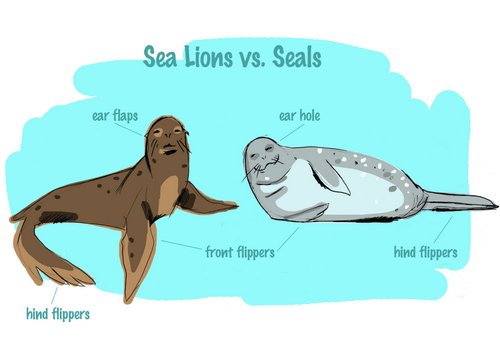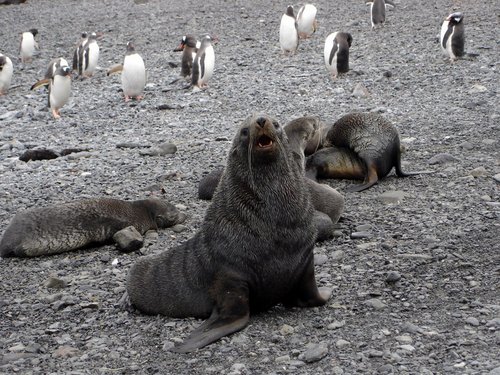This journal is brought to you by…
 Our ‘vet’ Rachel holding three of your flags. Photo credit: Alex Eilers
Our ‘vet’ Rachel holding three of your flags. Photo credit: Alex Eilers
- Linda Hall and her 2nd grade class at Riverwood Elementary School
- Mrs. Lavarreda and her amazing class at Lamplighter Montessori School
- Ms. Sousan and her 3rd grade class at Northpoint Christian School
Think about the people in your family.
Families are made up of all sorts of great people like your parents, siblings, grandparents, aunts, uncles and cousins.
Have you noticed people from the same family often look similar? Maybe family members have the same hair color or the same dimple on their chin! Families may also share similar interests or mannerisms. But, people in a family can also be different from one another. The same is true with the Weddell seal’s family. Let’s take a closer look at their family members and see how they are alike and different!
It’s all in the family
Let’s talk about the pinnipeds.
What’s a pinniped, you ask? That’s a great question. Pinnipeds are marine mammals that can live on land and in water. Pinniped means ‘fin-’ or ‘feather-’ footed, referring to their flippers.
There are three main types of pinnipeds or scientifically speaking, three families in the suborder Pinnipedia.
- Phocids - true seals
- Otariids - also called ‘eared seals,’ include seal lions and fur seals
- Odobenids - the only member of this family is the walrus
 Meet the pinniped family… Well the pinniped suborder.
Meet the pinniped family… Well the pinniped suborder.
What do pinnipeds have in common?
- They are all mammals, which means they are warm-blooded, have live birth (there is one mammal family that lays eggs, but all the rest give live birth), nurse their young, breath air and have hair.
- They are carnivores, which mean they eat only other animals. Do you know what kind of meat Weddell seals eat? They love fish!
- They have webbed flippers, used mostly for swimming. Two front (fore flippers) and two in back (hind flippers).
What’s different about pinnipeds?
It’s pretty easy to see the difference between a walrus and seal. Neither seals nor sea lions have huge tusks! But that wasn’t always the case, the walrus family used to be much more diverse, and many walrus didn't have tusks!
 Look at those tusks! This guy is easy to recognize. Photo credit: Bill Curtsinger, National Geographic
Look at those tusks! This guy is easy to recognize. Photo credit: Bill Curtsinger, National Geographic
It’s a little trickier telling the difference between a sea lion and a seal.
Let’s take a look at this chart.
 What is the difference between a seal and a sea lion? Use this chart to help you identify between the two. Photo credit: Lindsey Newton
What is the difference between a seal and a sea lion? Use this chart to help you identify between the two. Photo credit: Lindsey Newton
Now that you know some of the differences, look at the drawing below. Which drawing is a seal and which is a sea lion?
 Which is a seal? Which is a sea lion? Can you tell the difference? Photo credit: Meredith Olinger
Which is a seal? Which is a sea lion? Can you tell the difference? Photo credit: Meredith Olinger
If you said the seal is on the right, you would be correct!
Here’s something neat I learned while learning about Pinnipeds.
Be careful! Seal names can be tricky!
You can’t always rely on their names to tell the difference. Take a look at this Antarctic fur seal and this crabeater seal. They both have ‘seal’ in their name but one is a phocid, or true seal, and the other is an otariid, or eared seal.
Which one is which?
Compare the two and send your answer to me in the ‘Ask the Team’ section.
 This is an Antarctic fur seal. Is it a phocid or otariid? Photo credit: Thomas O’Donnell. Animal Diversity
This is an Antarctic fur seal. Is it a phocid or otariid? Photo credit: Thomas O’Donnell. Animal Diversity
 This is a Crabeater seal. Is it a phocid or otariid? Photo credit: Alex Eilers
This is a Crabeater seal. Is it a phocid or otariid? Photo credit: Alex Eilers
To be good scientist, we can’t just rely on the name to tell us is a pinniped is a seal, a sea lion or a walrus. We need to make our own observations and draw conclusions based on what we observe!
In class activity:
Can you draw a Venn diagram for the Pinniped family? List the similarities and differences between seals, sea lions and walruses. Hypothesize why one animal is better suited for an artic environment. Do you have any observations to support your hypothesis?
 List the similarities and differences between seals, sea lions and walruses in the Venn diagram.
List the similarities and differences between seals, sea lions and walruses in the Venn diagram.
- What features make the Weddell seal well-suited for its Antarctic environment?
- What observations support your answer?


Comments